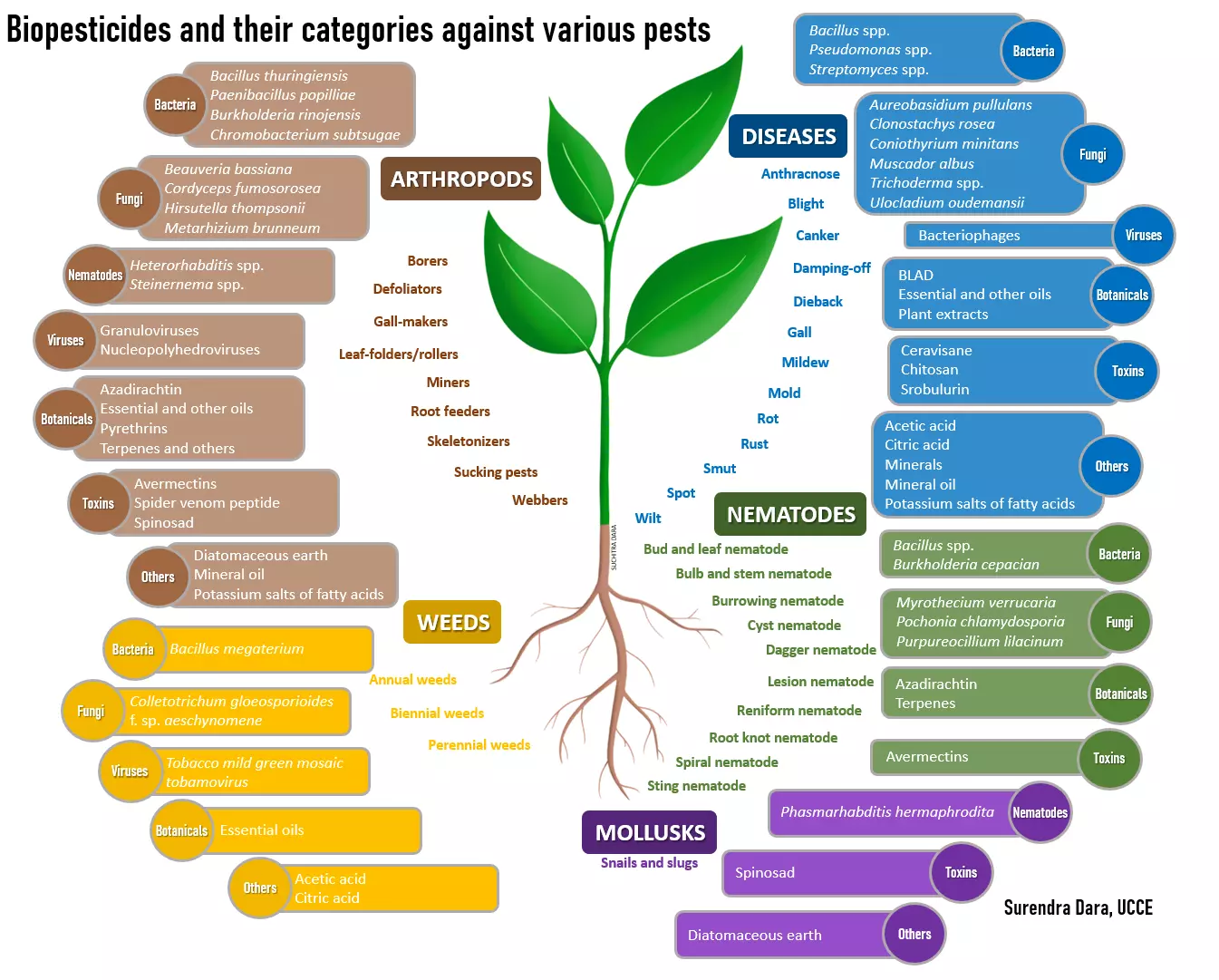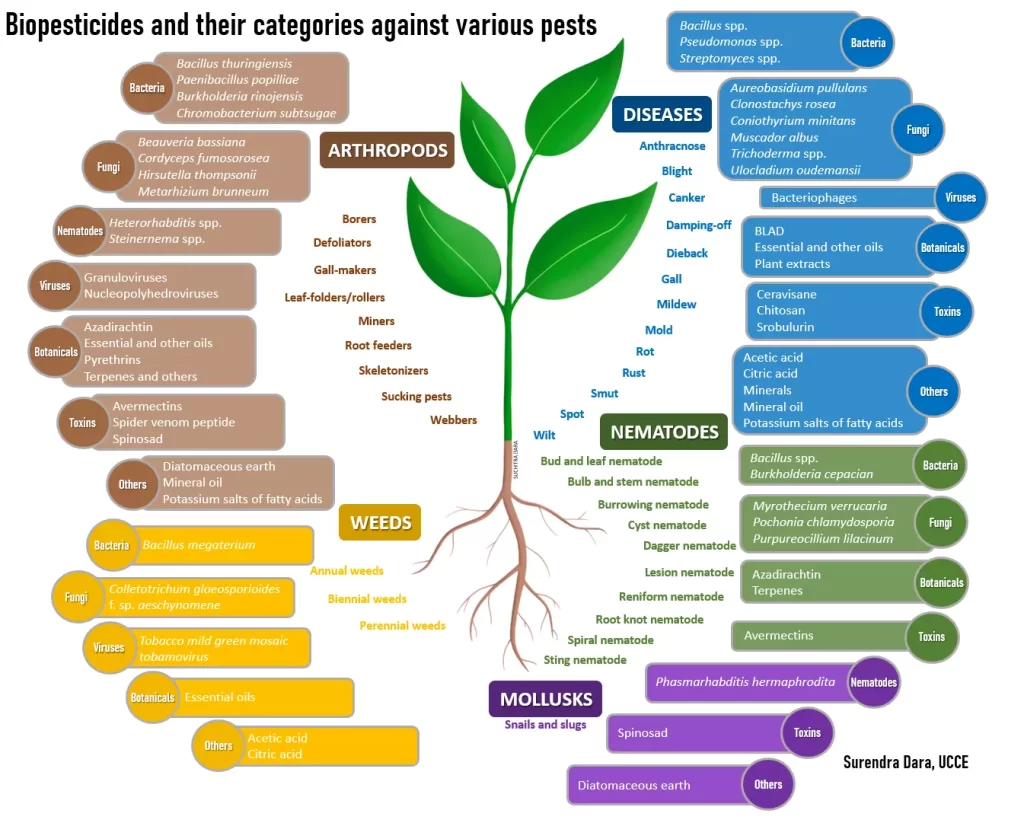Biocontrol in Farming
Globally, around 3 billion tons of pesticides are used annually to prevent diseases and pests from harming crops, yet 40% of crops are still lost due to plant diseases [1]. Adapting biocontrol in farming is a natural way to prevent and treat diseases; it can significantly reduce crop loss while avoiding the use of chemical pesticides. Additionally, biocontrol methods compared to chemical pesticides are more cost-effective and more importantly, environmentally friendly. Biocontrol is likely safer for downstream human consumption (although comparative studies are needed to support this claim).
What is biocontrol?
Biocontrol, short for biological control, is the practice of controlling pests such as insects, mites, or plant pathogens by introducing a microorganism that can target or out-compete the pathogen. This method of treatment is an organically sourced alternative to chemical pesticides (which means it can also be used on organic crops).
Biocontrol in farming can include the use of bacteria, viruses, fungi, and nematodes (Fig. 1). Biopesticides, on the other hand, are a natural substance/pesticide that has been derived from plants, animals, microorganisms or minerals (Fig. 1) (e.g. canola oil and baking soda). Hence it is an overarching term, which includes biocontrol techniques under it.
Biocontrol vs biopesticide – Generally speaking, biopesticides are passive agents while biocontrols are active agents which seek out their targets.

One of the more common biocontrol approaches in farming includes the treatment of pests and insects by utilizing natural enemies. This can include methods such as importation, augmentation, and conservation of natural enemies [2]:
Importation – when a non-native pest (i.e. invasive species, foreign viruses, etc.) is the source of the problem and involves bringing in natural enemies and predators from the pests’ native environment.
Augmentation – a process involving the manipulation of a predator and/or their environment to increase their predatory success.
Conservation of natural enemies – maintaining natural predators or control methods in an environment.
These three methods are used successfully in traditional agricultural practices and can be adopted in hydroponic systems as well.
Here we discuss the use of “predatory” microorganisms, also known as microbial biocontrol agents, which either out-compete other pathogenic bacteria for nutrients or produce toxic secondary metabolites which kill or inhibit the growth of pathogens. Using microorganisms to prevent or treat disease in hydroponic systems is a natural, pesticide-free way of keeping your crops healthy.
Some inoculants can even have growth-promoting factors which can have advantageous effects for the crop, outside of disease management. Typically, the most common biocontrol agents used in hydroponic systems to combat disease include bacterial and fungal inoculants (Fig. 1). Biocontrol in farming can tackle diseases like powdery mildew or rots.
See the diseases you should be protecting yourself from by subscribing to our newsletter
Bacterial inoculants as Biocontrol in Farming:
Pseudomonas fluorescens has been shown to increase the yield of plants while protecting against Fusarium wilt [3]. P. fluorescens has also shown comparable effects at controlling powdery mildew to traditional fungicides [4] and can also reduce the effects of soft rot caused by Pectobacterium carotovarum [5].
Lysobacter capsici is an effective biocontrol agent against the fungus Phytophthora infestans [6]. L capsici is most effective against P. infestans at 15-25˚C. L. capsici can adapt an increased resistance to UV and copper ions when exposed to lower temperatures, such as 15˚C [6].
Lactobacillus plantarum has been shown to inhibit the growth of the fungi Penicillium roqueforti, Mucor circinelloides and mycotoxinogenic molds which attack cereal grains [7]. L. plantarum also has plant growth-promoting factors that can induce cereal germination [7].
Bacillus subtilis has been shown to suppress the growth of the nematode Meloidogyne incognita on tomato plants [8], which is a major pest in the Southeastern United States. Biocontrol using B. subtilis can also promote an increase in plant height and weight [8]. When B. subtilis is combined with the fungi Paecilomyces lilacinus, an even greater fungal inhibition and plant growth are observed and nematode populations are significantly reduced [8; 9]. Various strains of Bacillus can reduce the effects of soft rot, particularly in potatoes, caused by Pectobacterium carotovarum [5].
Serratia marcescens is effective at controlling the fungi Sclerotium rolfsii, as studied in greenhouse environments [10]. S. marcescens is also capable of significantly reducing the effects caused by the fungal pathogen Rhizoctonia solani, such as damping off, particularly in beans [10].
Fungal inoculants as Biocontrol in Farming:
Trichoderma asperellum can reduce symptoms of angular leaf spots in cucumbers [11] and reduce symptoms of soft rot caused by Pectobacterium carotovarum [5]. Trichoderma harzianum and Trichoderma atroviride have been shown to increase cucumber and tomato yield, respectively [11].
Gliocadium catenulatum produces compounds that can protect hydroponic cucumbers and tomatoes from Pythium and Fusarium infections [12;13].
Paecilomyces lilacinus was briefly mentioned above and works well in combination with B. subtilis to control tomato fungal infections caused by Meloidogyne incognita [9] but this fungus is also effective on its own at controlling nematode populations, particularly in greenhouse environments [14].
Verticillium chlamydosporium can reduce root galling but has a substantially higher success rate when combined with the bacterium Pasteuria penetrans [9].
Glomus etunicatum is an effective agent against controlling nematode populations in greenhouse caused by the nematode Heterodera glycines Ichinohe (aka soybean cyst nematode), and can also increase the development of soybean crops through promoting growth in root length and overall height [15].
The Future of Biocontrol
There is no one size fits all approach to treating disease in crops. Microbial biocontrol agents are in competition with chemical pesticides and have to reach the same or higher levels of effectiveness before they will be globally accepted as a better alternative. However, biocontrol tools are more environmentally friendly, and likely safer for human consumption than traditional chemical pesticides. Therefore they deserve the attention they are receiving and hopefully, biocontrol will become common practice in traditional agriculture, greenhouses, and hydroponic systems worldwide.
Research has gone into improving the effectiveness of biocontrol agents:
- Exposing microbes to changing environmental conditions (e.g. UV exposure, temperature, pH, drought, humidity) encourages the development of tolerance and resistance [16; 17].
- Introducing protective agents into the environment which the biocontrol agent can “uptake” into their cells – synonymously to picking up armour [16].
- Engineering bacteria to produce higher levels of favourable compounds such as antibiotics, bacteriocins and hydrolytic enzymes [16].
- Microbes can also be mixed together in a “cocktail” to enhance their antimicrobial abilities [9].
- Combinations such as Pseudomonas + Bacillus, Pseudomonas + Trichoderma, Serratia + Trichoderma and Glomus + Trichoderma have been shown to positively increase the inhibition of soil-borne pathogens [16].
Biocontrol agents provide a beneficial alternative which can improve crop yield, in addition to disease protection. If there is a disease outbreak in your hydroponic system, consider trying a biocontrol. We can help you decide which approach is best for you and give you a complete picture of the microorganisms in your hydroponic systems. Send us an email at [email protected] to get started!
Disclaimer:
The information we present in Pathogen Profile is based on collating published peer-reviewed scientific literature and sources we think are reliable. This is by no means an exhaustive review of pathogens. Pathogen Profile gives a small glimpse of what is known about pathogens and we encourage growers to do more research on their own based on the pathogens in relation to their own crops and hydroponic systems. The information presented in Pathogen Profile is for educational purposes and should not be used as professional advice to treat pathogens or to operate your hydroponic system.
References:
- Messing, R., & Brodeur, J. (2018). Current challenges to the implementation of classical biological control. BioControl, 63(1), 1–9. https://doi.org/10.1007/s10526-017-9862-4
- Orr, D. B. (n.d.). Biological control: Approaches and applications. Biological Control: Approaches and Applications | Radcliffe’s IPM World Textbook. Retrieved June 14, 2022, from https://ipmworld.umn.edu/landis
- El-Sharkawy, H. H. A., Abbas, M. S., Soliman, A. S., Ibrahim, S. A., & El-Nady, I. A. I. (2021). Synergistic effect of growth-promoting microorganisms on bio-control of fusarium oxysporum f. sp. pisi, growth, yield, physiological and anatomical characteristics of pea plants. Pesticide Biochemistry and Physiology, 178, 104939. https://doi.org/10.1016/j.pestbp.2021.104939
- Kumar, A. M., Ganeshan, G., Reddy, K.N., & Ramachandra, Y. L. (2008). Integrated disease management for the control of powdery mildew (Leveillula taurica (Lev.) Arn.) in Bell Pepper. The Asian and Australasian Journal of Plant Science and Biotechnology 2 (2), 107-112.
- Abd-El-Khair, H., Abdel-Gaied, T. G., Mikhail, M. S., Abdel-Alim, A. I., & El-Nasr, H. I. (2021). Biological control of pectobacterium carotovorum subsp. carotovorum, the causal agent of bacterial soft rot in vegetables, in vitro and in vivo tests. Bulletin of the National Research Centre, 45(1). https://doi.org/10.1186/s42269-021-00491-4
- Puopolo, G, Palmieri, M. C., Giovannini, O., & Pertot, I (2015) Impact of temperature on the survival and the biocontrol efficacy of Lysobacter capsici AZ78 against Phytophthora infestans. Biocontrol 60:681–689
- Quattrini, M., Bernardi, C., Stuknytė, M., Masotti, F., Passera, A., Ricci, G., Vallone, L., De Noni, I., Brasca, M., & Fortina, M.G. (2018). Functional characterization of Lactobacillus plantarum ITEM 17215: A potential biocontrol agent of fungi with plant growth promoting traits, able to enhance the nutritional value of cereal products. Food Res Int;106:936-944. doi: 10.1016/j.foodres.2018.01.074.
- Gautam, A., Z. A. Siddiqui, & I. Mahmood. (1995). Integrated management of Meloidogyne incognita on tomato. Nematologia Mediterranea 23:245–247.
- Meyer, S.L.F., & Roberts, D. P. (2002). Combinations of Biocontrol Agents for Management of Plant-Parasitic Nematodes and Soilborne Plant-Pathogenic Fungi. Journal of Nematology 34(1):1–8.
- Ordentlich, A., Elad, Y., & Chet, I. (1987). Rhizosphere colonization by serratia marcescens for the control of sclerotium rolfsii. Soil Biology and Biochemistry, 19(6), 747–751. https://doi.org/10.1016/0038-0717(87)90058-7
- Yedidia, I., Srivastva, A.K., Kapulnik, Y., & Chet, I., (2001). Effect of Trichoderma harzianum on microelement concentrations and increased growth of cucumber plants. Plant Soil 235, 235–242.
- Rose, S., Parker, M., & Punja, Z.K., (2003). Efficacy of biological and chemical treatments for control of fusarium root and stem rot on greenhouse cucumber. Plant Dis. 87, 1462–1470.
- Khalil, S., & Alsanius, B.W. (2010). Evaluation of biocontrol agents for managing root diseases on hydroponically grown tomato. J. Plant Dis. Protec. 117, 214–219.
- Anastasiadis, I. A., Giannakou, I. O., Prophetou-Athanasiadou, D. A., & Gowen, S. R. (2008). The combined effect of the application of a biocontrol agent Paecilomyces lilacinus, with various practices for the control of root-knot nematodes. Crop Protection, 27(3-5), 352–361. https://doi.org/10.1016/j.cropro.2007.06.008
- Benedetti, T., Antoniolli, Z. I., Sordi, E., Carvalho, I. R., & Bortoluzzi, E. C. (2021). Use of the glomus etunicatum as biocontrol agent of the soybean cyst nematode. Research, Society and Development, 10(6). https://doi.org/10.33448/rsd-v10i6.15132
- Marian, M., & Shimizu, M. (2019). Improving performance of microbial biocontrol agents against plant diseases. J Gen Plant Pathol 85, 329–336 https://doi.org/10.1007/s10327-019-00866-6
- Daranas, N., Badosa, E., Francés, J., Montesinos, E., & Bonaterra, A. (2018) Enhancing water stress tolerance improves fitness in biological control strains of Lactobacillus plantarum in plant environments. PLoS ONE 13:e0190931
Looking for more useful info? Go back to the Blog Page or checkout the Resources Page.
![]()
Becky Anderson is a Lab expert and Science Communicator at Healthy Hydroponics





